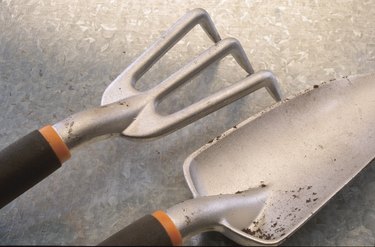
Powdery mildew is the bane of gardeners of many types of plants. It is caused by a group of fungi that live on the above-soil plant tissues but whose spores overwinter in the soil and re-infect a plant when conditions are favorable, according to the Colorado State University Extension Service. Fungi-friendly conditions include periods of high humidity, cool or warm temperatures, shade and poor air circulation. While powdery mildew does not typically kill a plant, it will irrevocably discolor and disfigure the buds, blooms and foliage that it infects. Soil controls are mostly cultural and revolve around keeping the soil from being splashed up or carried up onto tender plant tissues.
Step 1
Clear up all debris from the surface of the soil anywhere you suspect powdery mildew. Powdery mildew spores can breed on the dropped leaves, petals and bits of branches sitting on the soil surface. The spores are then transferred up to the plant tissues when splashed by watering, wind or even insect activity.
Video of the Day
Step 2
Refrain from composting any debris pruned from or gathered from under plants suspected of harboring powdery mildew as the temperature in compost piles does not rise high enough to kill the spores.
Step 3
Inoculate some powdery mildew spores on the surface of the soil by spraying some of the same fungicide used to treat powdery mildew on the foliage. Look for a product containing neem oil, sulfur, triforine or potassium bicarbonate and apply as recommended on the product label. Choose a fungicide safe for your type of plant and whether the plant is ornamental or edible.
Video of the Day